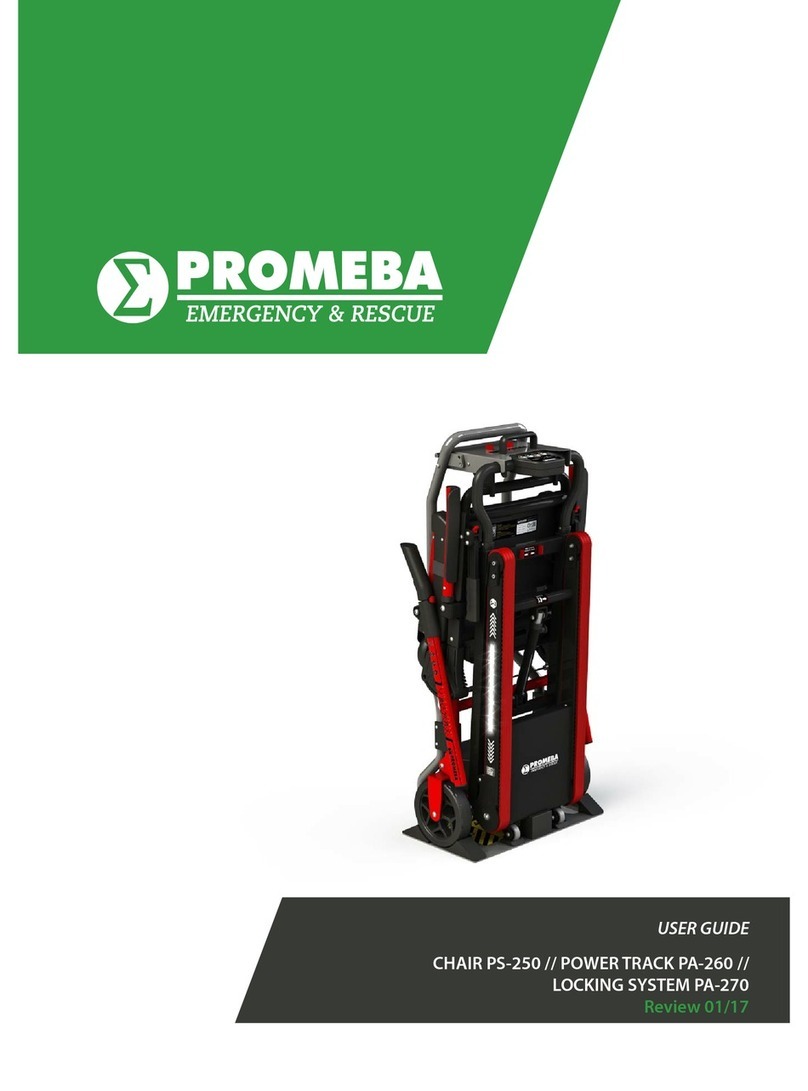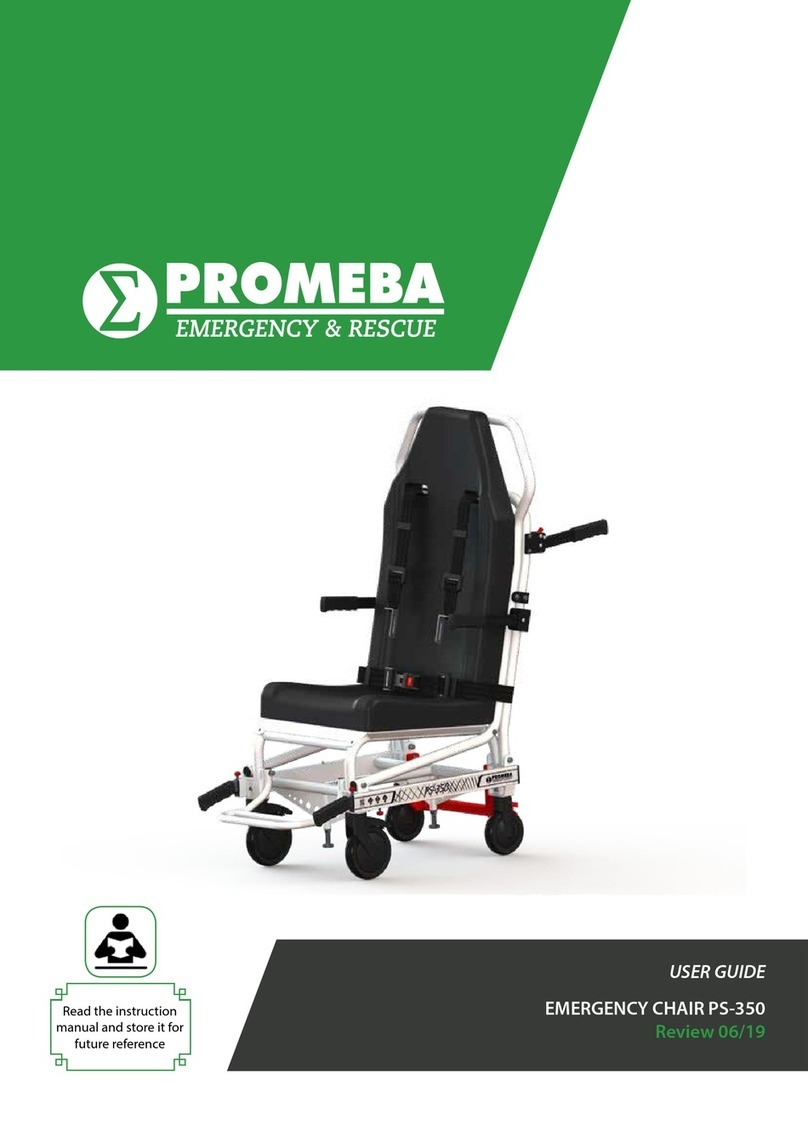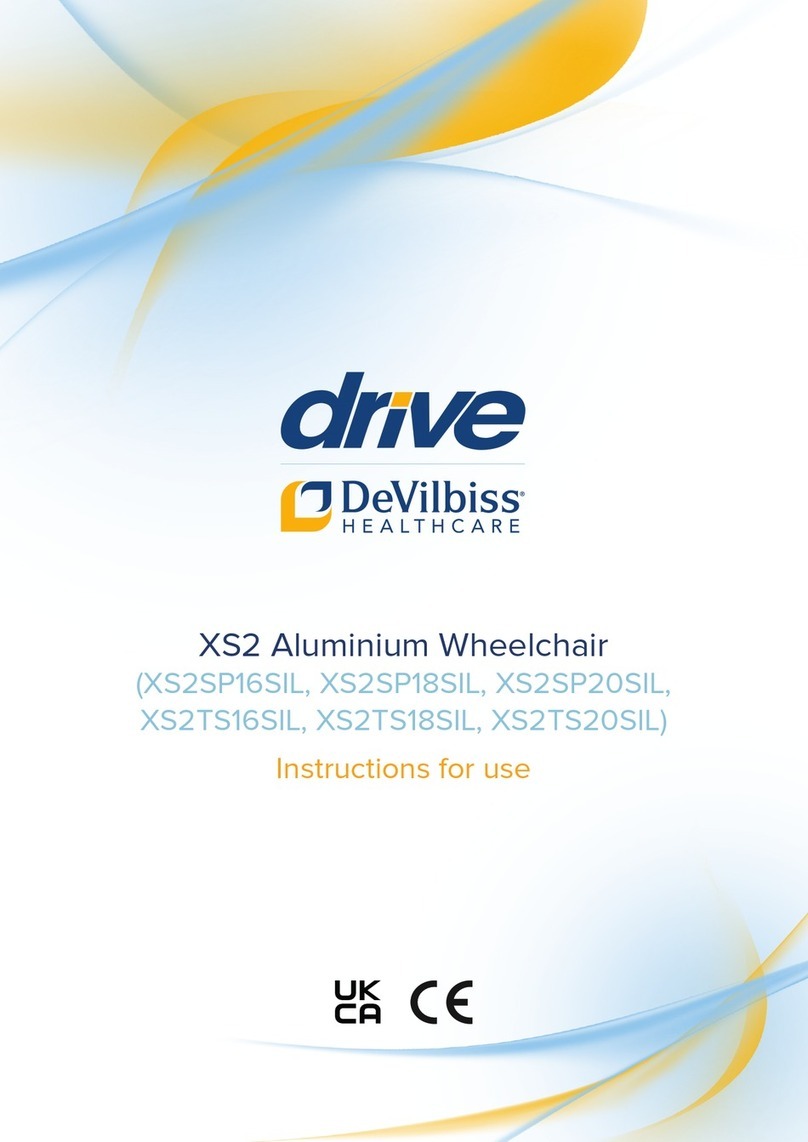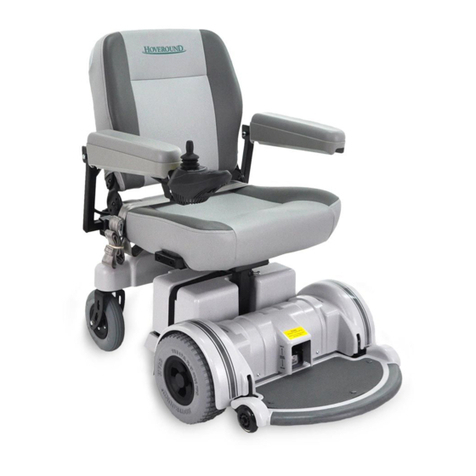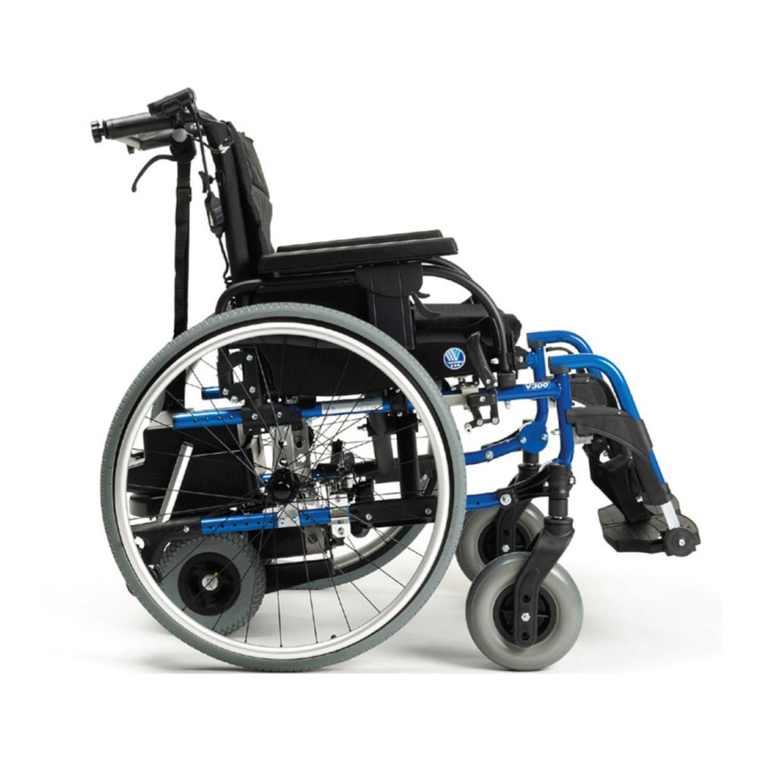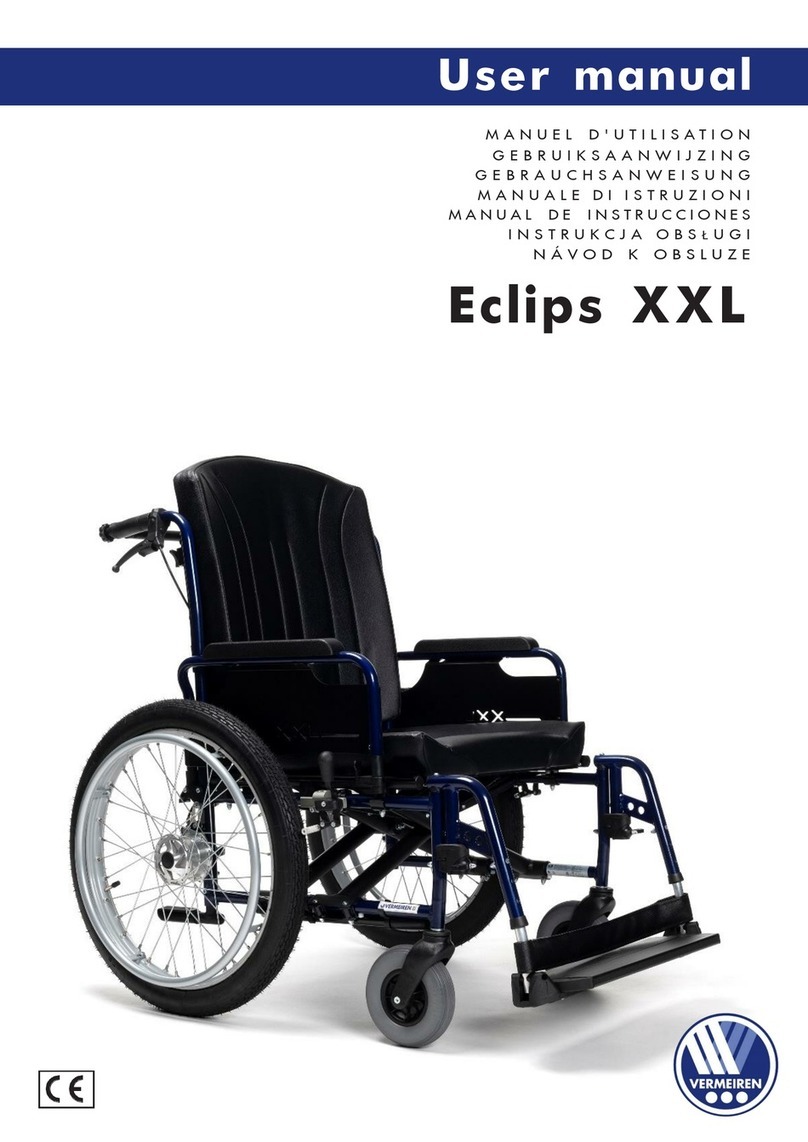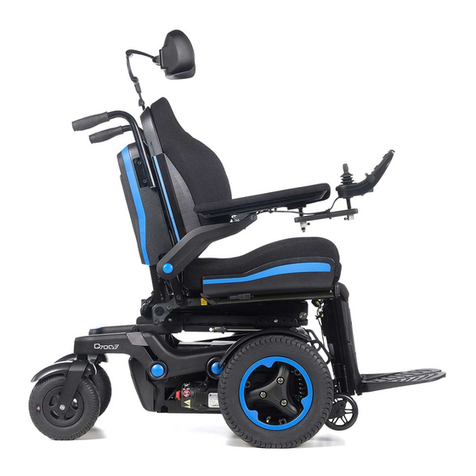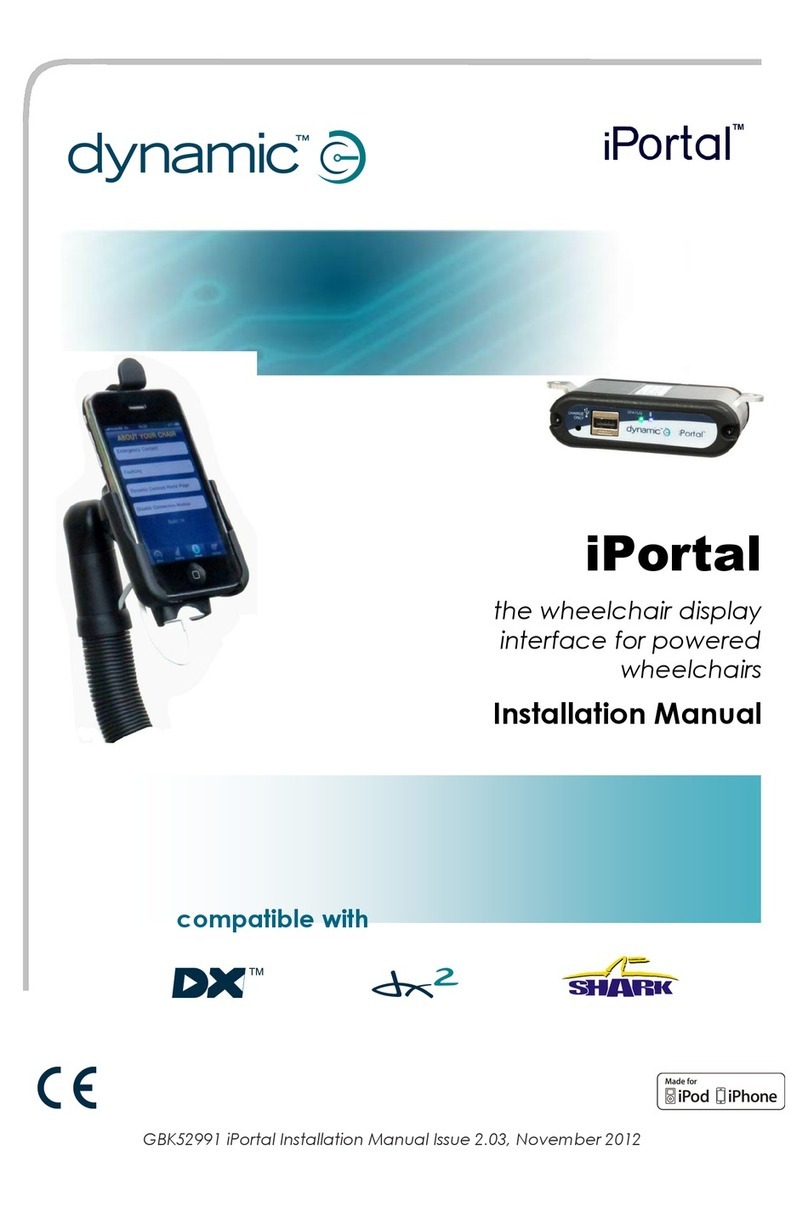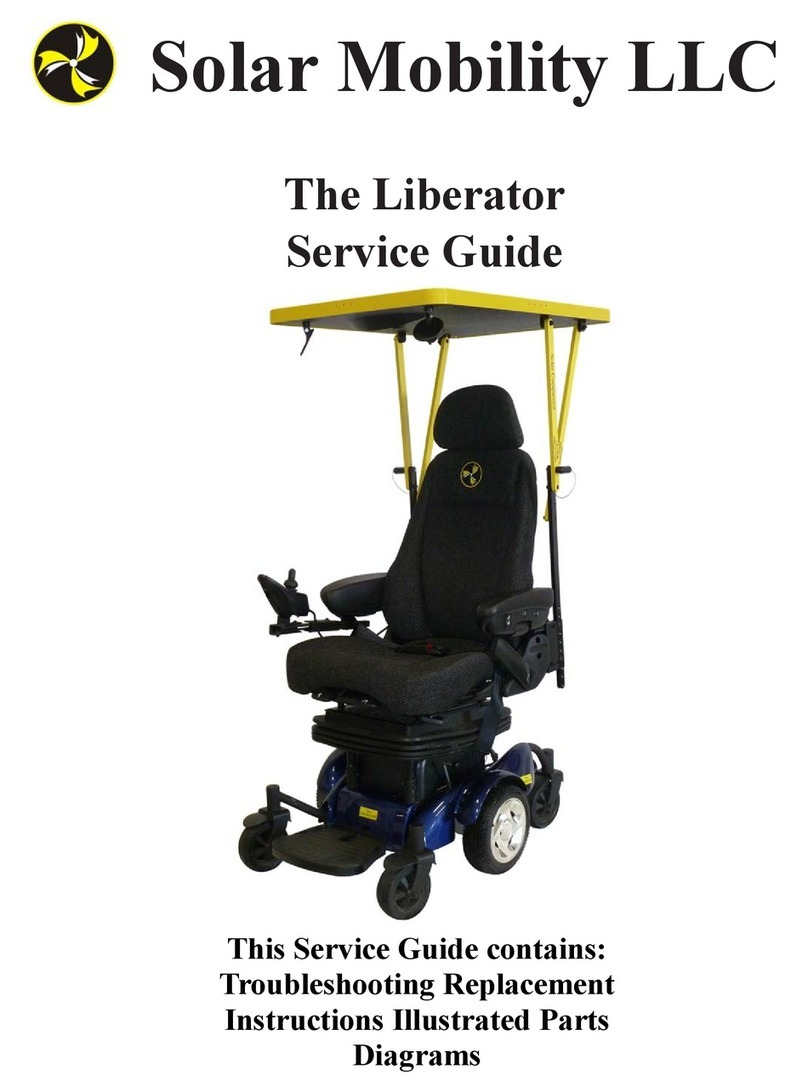Promeba PS-350 User manual

USER GUIDE
EVACUATION SEDAN CHAIR PS-350
Review 2021/07


USER GUIDE // EVACUATION SEDAN CHAIR PS-350
Review 2021/07
3
INDEX
01 INTRODUCTION
01.1 Using this manual
01.2 Legend of symbols
01.3 Servicing request
01.4 Demolition
01.5 Labelling
01.6 Contraindications and adverse eects
01.7 Physical requirements of the operators
01.8 Intended purpose
01.9 General warnings
01.10 Specic warnings
01.11 Residual risk
01.12 Reference standards
01.13 Life span
02 PRODUCT DESCPRIPTION
02.1 Main components
02.2 Technical data sheet
02.3 Features
03 OPERATION
03.1 Transport and storage
03.2 Preparation
03.3 Functioning
03.4 Troubleshooting
04 GENERAL MAINTENANCE
05 SPARE PARTS
06 TRAINING REGISTER
07 MAINTENANCE REGISTER
08 LEGAL NOTICES
09 PRODUCT WARRANTY
05
05
05
05
06
06
06
06
07
07
09
11
11
11
12
12
13
13
14
14
14
15
17
18
19
20
21
22
23


USER GUIDE // EVACUATION SEDAN CHAIR PS-350
Review 2021/07
5
01.1 Using of manual
The manual provides using and maintenance instructions of the product as well as technical aspects, func-
tioning, spare parts and safety.
It is recommended before the operation of the product to read carefully this manual in order to avoid da-
mages caused by a misuse.
Do not lose this document. It should be accessible to any doubt that could appear by medical personnel.
Remember that a good use and maintenance are necessary for the proper operation of the product.
01 INTRODUCTION
01.3 Servicing request
For information of the correct interpretation of the instruction manual, the use, maintenance, installation
and restoration of the product, please contact Promeba customer service: T. 93 837 12 00, email prome-
[email protected] or write to PROMEBA, S.L. - Ctra C-16 Km 59.5 · 08650 Sallent (Barcelona) · SPAIN.
01.2 Legend of Symbols
SYMBOL EXPLANATION / DESCRIPTION
MANUFACTURER symbol. This symbol is accompanied by the name and address of the manufac-
turer, adjacent to the symbol (PRODUCTOS METÁLICOS DEL BAGÉS S.L., Ctra. C-16 Km 59.5, 08650
Sallent (Barcelona)).
Indicates the manufacturer’s reference number to identify the medical device.
PROMEBA, S.L. uses this symbol to set each internal reference for each conguration and business
variant.
Indicates the manufacturer’s serial number to identify a specic medical device.
Indicates the manufacturing date. The symbol must be accompanied by a manufacturing date
(yyyy-mm), adjacent to the symbol.
It is placed to inform that the product is a“Medical Device”.
CE symbol without the intervention of a Notied Organism, as a Medical Device classied as Class I
according to the EU Regulation 2017/745 on Medical Devices.
Symbol for the Unique Device Identier.
Symbol“See instructions for use or operating instructions”.
Symbol “caution”. This symbol is placed to warn of the need for the user to refer to important pre-
cautionary information in the operating instructions, such as warnings and cautions not otherwise
found on the label.
Symbol“Caution”. For a general warning.
Warning, crushing of hands
Indicates the temperature limits. The upper and lower temperature limits should be indicated adja-
cent to the horizontal lines.
+40ºC
-20ºC

USER GUIDE // EVACUATION SEDAN CHAIR PS-350
Review 2021/07
6
01.4 Demolition
When the devices are no longer suitable for use, if they have not been contaminated by any particular
agent, they can be disposed of as normal solid waste, otherwise, follow the current demolition regulations.
01 INTRODUCTION
01.6 Contraindications and adverse eects
The use of this device, if used as described in this manual, does not present any contraindications or colla-
teral eects.
01.5 Labelling
Each product incorporates an identication label, placed on the device itself and/or on the box. It must ne-
ver be removed or covered. This label includes the serial number and the product code. Please keep these
numbers so you can inform the dealer if necessary.
01.7 Physical requirements of the operators
Promeba evacuation chair is destined to professional use only.
The operators must be trained in ecient, eective and safe patient transport and must have the following
minimum requirements:
- Physical capacity for operating the device
- Be able to seize the device rmly with both hands
- Have strong back, arms and legs for lifting, pushing and pulling the chair
- Have a good muscular coordination
It is recommended the employment of two operators equipped with strength, balance, coordination and
common sense. Patient loading procedures for extremely heavy patients, operations in rough terrain and in
particular situations more operators may be needed.
The capacities of the various operators must be considered before determining his role in
the employment of the stretcher.

USER GUIDE // EVACUATION SEDAN CHAIR PS-350
Review 2021/07
7
01.8 Intended purpose
The EVACUATION CHAIR product is designed to load and transport patients in a sitting position from the
rescue site to the ambulance or other device.
When anchoring the electric track, the product ELECTRIC CHAIR is indicated to eortlessly transport pa-
tients (over 40kg) in hospital and pre-hospital environments thanks to its electric transport function when
going up and down stairs.
The PS-350 chair oers greater comfort and does not require any type of transhipment, since the chair can
be anchored to the oor of the ambulance safely.
01 INTRODUCTION
01.9 General warnings
1. The product must be used by trained personnel only, having attended specic training for this device and
not for similar products.
2. At least every 6 months, is important to verify if updated User Manuals are available or there is any change
involving your product. This information is freely available on the website http://promeba.com/
3. Training routines must be registered on a special register in which the names of those trained, of the
trainers, date and place are indicated. This register, which will certify the eligibility of the operators to use
the Promeba, S.L. device, has to be kept for a period of 10 years after the disposal of the device itself. This
register will be made available to the competent authorities and/or manufacturer if requested.
4. Promeba, S.L. is always at your disposal to plan trainings on products.
5. Before carrying out any kind of operation on the appliance (training, installation, use), the operator must
carefully read the enclosed instructions, paying particular attention to the correct safety precautions and to
the procedures to be followed for installation and for correct use.
6. If the instructions belong to another device and not the device received, inform the manufacturer imme-
diately and avoid use of the device.
7. In the case of any doubts as to the correct interpretation of the instructions, please contact Promeba, S.L.
for any necessary clarications.
8. Do not allow untrained persons to help during the use of the device, because they could cause damage
to the patient or to themselves.
9. Periodically check the device, carry out the prescribed maintenance and respect the life span indicated by
the manufacturer in this user manual.
10. Before each use of device the perfect operating state of the device must be checked as specied in the
instruction manual. If any damage or abnormalities which could in any way inuence the correct functio-
ning and the safety of the device, of the patient and/or of the user are detected, the device must be imme-
diately removed from service and the manufacturer must be contacted.
11. If any failure or incorrect functioning of the device is detected, it must be immediately substituted with
a similar item so that the rescue procedures are guaranteed without any interruption.
12. Use of the device in anyway other than described in this manual is forbidden.
13. Do not alter or modify in any way the device; any such interference could cause malfunctions and injury
to the patient and/or rescuer.

USER GUIDE // EVACUATION SEDAN CHAIR PS-350
Review 2021/07
8
01 INTRODUCTION
14. The device must not in any way be tampered with (modication, adjustment, addition, replacement).
In such cases all responsibility will be denied for any malfunctions or injuries caused by the appliance itself;
moreover CE certication and product warranty will be considered void.
15. Those who modify or have modied, prepare or have prepared medical appliances in such a way that
they no longer serve the purpose for which they were intended, or no longer supply the intended service,
must satisfy the valid conditions for the introduction onto the market.
16. Handle with care.
17. Ensure that all the necessary precautions are taken in order to avoid the hazards that can arise as the
result of contact with blood or body uids.
18. Register and store with these instructions: lot number, place and date of purchase, rst date of use, date
of checks, name of users, any comments.
19. When the device is being used, the assistance of qualied sta must be guaranteed.
20. Do not store the device underneath any heavy objects which could cause structural damage.
21. Store in a cool, dry, dark place and do not expose to direct sun.
22. Store and transport device in its original packaging.
23. The device must not be exposed or come into contact with any source of combustion or inammable
agents.
24. Position and adjust the device taking care not to cause any obstruction to rescuers and or any other
rescue equipment.
25. Attention: laboratory testing, post production tests and instruction manuals cannot always consider
every possible scenario for use. This means that in some cases the performance of the product could be
notable dierent from results to date obtained. Instructions are continually being updated and are under
tight surveillance of fully qualied stas with adequate technical formation.
26. Both public and private operators are obliged to report any accident involving any medical device to the
Ministry of Health and the manufacturer as specied and within the time given by European regulations.
27. Both public and private operators are obliged to inform the manufacturer of the measures to be taken
to guarantee the safety and health of patients and users of any medical device.
28. As a distributor or end user of the products manufactured and/or distributed by Promeba, S.L., you are
strictly obliged to know the legal provisions in force in the country of destination of the goods, applicable
to the devices to be supplied (including the regulations relating to technical specications and/or safety re-
quirements) and, therefore, understand the necessary requirements to ensure compliance of the products
themselves with all the legal requirements of the territory.
29. Promptly notify PROMEBA regarding any revisions to be made by manufacturer in order to guarantee
the conformity of the product to the territory’s legal specications (including those resulting from rules
and/or norms of other nature).
30. Act with all due care and diligence, and contribute to ensure conformity to general safety requirements
of all devices marketed in the territory, by providing nal users with all necessary information for carrying
out periodical checks on their devices, as specied in the relevant user manual.
31. Actively contribute to product safety checks on products sold, by communicating any relevant risk
analysis information both to the manufacturer and to any competent authorities so that the necessary ac-
tions can be promptly taken.

USER GUIDE // EVACUATION SEDAN CHAIR PS-350
Review 2021/07
9
01 INTRODUCTION
1. Establish a maintenance program and periodic testing, identifying a reference employee. The person to
whom the ordinary maintenance of the device is entrusted must ensure the basic requirements foreseen by
the manufacturer in the user’s manual.
2. Use only accessories/spare parts that are original or approved by Promeba, S.L. when carrying out any
operation, to avoid causing any alteration or modication to the device, otherwise we assume no responsi-
bility for the proper functioning or damage resulting from device to the patient or the operator and warran-
ty will be considered void.
3. Always respect the maximum capacity of the device, as indicated in this user’s manual. Maximum load
capacity means the total weight distributed according to the human anatomy. In determining the load of
the total weight on the product, the operator must consider the weight of the patient, the equipment and
the accessories. Moreover, the operator must consider that the overall dimensions of the patient do not
reduce the functionality of the device.
4. Never leave the patient unassisted on the device, because he may be injured.
5. Do not use bleach to disinfect the product. Use a hydroalcoholic based disinfectant and wash with water.
6. The device and all its components, after washing, should be allowed to dry completely before storing.
7. Do not wash the product in a washing machine or dry it in a dryer machine.
8. Lubrication must be carried out after cleaning and complete drying.
9. Follow procedures approved by Emergency Medical Services for immobilization and transportation of
the patient.
10. Follow procedures approved by Emergency Medical Services for positioning and transporting the pa-
tient.
11. Avoid contact with sharp objects.
12. Do not use the device if it is pierced, torn or frayed.
13. Make sure, before lifting, that the operators have a rm grip on the device.
14. Avoid pulling the device on rough surfaces.
15. The device is a evacuation chair for patients transport and cannot be used as a stationing device.
16. Do not lift the transport chair with a crane or other mechanical lifts.
17. First practice with an empty chair in order to get used to the way in which the stretcher maneuvers.
18. For the use of the device, one operator in suitable physical conditions is needed, with strength, balance,
coordination, and common sense and must be trained on the correct functioning of the device Promeba,
S.L. stretcher.
01.10 Specic warnings
32. Be aware that in the event of any failure to conform to the above mentioned requirements you will be
deemed fully responsible for all damages that might occur. Therefore we expressly disclaim any responsibi-
lity and/or liability for your non-compliance with the present“Regulatory provisions”.

USER GUIDE // EVACUATION SEDAN CHAIR PS-350
Review 2021/07
10
01 INTRODUCTION
19. For particularly heavy patient loading and for rescue operations on steep terrain or in unusual circum-
stances, the presence of more operators is recommended (not just one as required under standard condi-
tions).
20. The maximum weight supported by each sanitary technician must comply with the requirements pres-
cribed by the law of each country, regarding Occupational Health and Safety.
21.Before each use check the integrity of the belts and their hooks, as specied in the user’s manual. In case
of malfunction or damage that may compromise the function and safety of the device, patient or operator,
it is necessary to replace the belts.
22.Make sure the belts are properly fastened to the frame of the stretcher.
23.Always immobilize the patient using the belts supplied by the manufacturer; lack of immobilization can
cause serious damage.
24.Use the stretcher only as described in this user’s manual.
25.Do not alter or modify the evacuation chair arbitrarily to make it t into the ambulance: the modication
may cause unforeseeable functioning and damages to the patient and operators. In any case the warranty
will be lost.
26.Pay a lot of attention to possible obstacles (water, ice, debris, etc.) on the route of the stretcher, because
they could cause loss of balance for the operator and compromise the proper functioning of the device. If
you cannot set the path free from obstacles, choose an alternative path.
27. For very steep slopes the device must be raised. Always hold the frame or the telescopic handles to lift
and transport the chair.
28.Condensation, water, ice and accumulations of dust can aect the correct operation of the device, ma-
king it unpredictable and causing a sudden alteration of the weight that operators have to carry.
29. The transport chair is certied for use with the specic xing system of Promeba S.L., therefore the use
of any other fastener not approved by the manufacturer is prohibited. Fixing systems that have not been
approved can alter the structural and functional characteristics of the chairs
30. Replace the wheels with original parts, in case the device does not stop.
31. To avoid injury, always check that the carry handles are properly locked before lifting the chair.
32. It is recommended not to use the chair if it is suspected that the patient may have cervical trauma, da-
mage to the spine or fractures.
33. To avoid risks to the safety of the patient and the operator, during transport on stairs it is recommended
that at least two operators are present.
34. Use the brakes only when transferring the patient or when no one is on the chair. If the chair is moved
with the brakes locked, it could tip over and cause injury to the patient, operator, or equipment.
35. Brakes are used only to prevent the empty chair from moving when unsupervised, and as an aid during
patient transfer. The brakes cannot provide enough resistance to keep the chair fully braked on all surfaces
or with a load on the chair.
36. Never use the brake on a chair with badly worn wheels, as it could aect the locking ability of the brakes,
and therefore cause possible injury to the patient, operator or equipment.

USER GUIDE // EVACUATION SEDAN CHAIR PS-350
Review 2021/07
11
01.13 Life span
If used as described in the following instructions, this device has a useful life of 10 years from the date
of purchase.
This useful life can be extended with annual reviews carried out by the manufacturer, which uses speciali-
zed and authorized internal and external technicians.
In case these annual checks are not carried out, the device must be disposed of according to the informa-
tion in paragraph 01.4 and the manufacturer must be notied.
Only the manufacturer or an authorized center can extend the life of the device, if it meets the safety requi-
rements.
Promeba, S.L. will not accept any responsibility for malfunction or damage caused by the use of devices
that have not been checked by the manufacturer or authorized center, or that have exceeded the maximum
allowed useful life.
01.12 Reference standards
01.11 Residual risks
The residual risks listed below have been identied only with reference to the intended use of the device:
1. Use by untrained personnel may result in injury to patient, operator, or third parties.
2. Inappropriate disinfection procedures can create a risk of cross infection.
3. If the device is not locked in the xation system or is not positioned correctly, it could result in sudden and
dangerous movements, which could cause injury to the patient and the operators. Always make sure that
the locking system is properly anchored.
4. Failure to comply with the warnings for operators can create risks.
5. Failure to read and understand the product instructions can result in injury to the patient and operators.
REFERENCE TITLE OF DOCUMENT
UNI EN ISO 1865-1 Patient handling equipment used in road ambulances. Part 1. General stretcher
systems and patient handling equipment
UNI EN 1789 Medical vehicles and their equipment. Road ambulances
As a distributor or end user of the products manufactured and/or distributed by Promeba,
S.L., you are strictly obliged to know the legal provisions in force in the country of destination
of the goods, applicable to the devices to be supplied (including the regulations relating to
technical specications and/or safety requirements) and, therefore, understand the necessary
requirements to ensure compliance of the products themselves with all the legal requirements
of the territory.

USER GUIDE // EVACUATION SEDAN CHAIR PS-350
Review 2021/07
12
02 PRODUCT DESCRIPTION
02.1 Main components
Nº DESCRIPTION OF COMPONENTS
1 Structure
2 Telescopic handles
3 Upper handles
4 Lower handles
5 Belts
6 Mattress
7 Front wheels
Nº DESCRIPTION OF COMPONENTS
8 Rear wheels
9 Foot rest
10 Anchor system for track
11 Anchor for locking system
12 Locking system
13 Electric track
3
10
4
7
8
2
9
5
6
11
1
12
13

USER GUIDE // EVACUATION SEDAN CHAIR PS-350
Review 2021/07
13
02.2 Technical data sheet
02 PRODUCT DESCRIPTION
LENGTH 875 ±5 mm MAX LOAD 250 Kg
WIDTH 570 ±5 mm FRONT WHEELS Swivel Ø150x34 mm
HEIGHT 1190 ±5 mm REAR WHEELS Locked with brake Ø125x35 mm
WEIGHT w/o mattress, w/o belts 18 Kg OPERATORS REQUIRED 2
WEIGHT mattress & belts 2 Kg HANDLES 4 (2 front + 2 rear)
570 ±5
470 ±5
565 ±5
875 ±5
1140 ±5
1190 ±5
02.3 Features
1. Use for emergency situations in elderly people, public safety, hospitals, hotels, etc.
2. Foldable armrests.
3. Four wear resistant wheels.
4. Telescopic handles with the possibility of total extraction.
5. Seat and backrest with heat sealed seams for a great hygiene and easy to clean.
6. Two locking points device for the ambulance.
7. Electric track anchor for easy going up and down stairs.

USER GUIDE // EVACUATION SEDAN CHAIR PS-350
Review 2021/07
14
03 OPERATION
03.1 Transport and storage
Before transporting the appliance, make sure that it is correctly packaged.
During transport always x the load. If piling up is necessary always follow
the scheme shown on gure 1.
Transport the leveled load and following all precepts and rules for the
transport of loads, ensuring also that there are no risks of shocks, bumps
or falls during the transport itself.
To unpack the device place the box on a at, stable surface and carefully
open the seal. Remove the device from the inside of the box following the
scheme shown on gure 2.
Keep the original packaging for use in case of any further transport and
for storage.
Damage to the appliance caused during transport and handling is not co-
vered by the guarantee. Repairs or replacement of the damaged parts are
the responsibility of the client.
The device must be stored in a dry, cool area away from direct sunlight.
It must not be placed in contact with any substances or chemical agents
which could cause damage and reduce safety characteristics.
03.2 Preparation
On receipt of the product:
- Remove the packaging and display the material so that all components are visible.
- Check that all the components/pieces on the accompanying list are present.
The appliance must be checked before every use so as to reveal any working abnormalities and/or damage
caused by transport and/or storage. In particular, check:
- General functionality of the device
- Cleaning the device (remember that the lack of cleaning can cause the spread of infections)
- Absence of cuts, holes, breaks in the structure, including the belts
- Correct xing of all nuts, bolts and screws
- Correct attachment of the belts to the chair
- Correct operation of the belt closure
- Condition of moving parts, wheels and belts
- Integrity of the seams
- There are no tubes or metal sheets that show bends or cracks.
- The backrest and the seat do not show damage or structural cracks
- The welds are intact, without cracks or breaks.
- Wheels are securely xed, stable and work properly.
- Wheels are free of dirt or debris
- Brakes work properly
- Track belts run and have the correct tension for use
- Correct operation of the springs
- Armrests raise and lower correctly
- The transport handles open, close and lock correctly.
- Telescopic handles open, close and lock properly
- Presence of all labeling
- Lubrication of moving parts
- The emergency vehicle is equipped with the locking system for the PS-350 chair
If the above conditions are met, the device may be considered ready for use; otherwise you must immedia-
tely remove the device from service and contact the manufacturer.
PACKING UNIT
RESPECT THE PACKAGING TRANSPORT POSITION
UNPACKING THE PRODUCT
ALWAYS USE FLAT SURFACE
FIGURE 1
FIGURE 2

USER GUIDE // EVACUATION SEDAN CHAIR PS-350
Review 2021/07
15
03 OPERATION
03.3 Functioning
03.3.1 ARMRESTS
Lower the armrest into the operating position, holding it and pushing it down, until you meet resistance.
To close it again, lift it up to the previous position.
03.3.2 TRANSPORT HANDLES
To close the transport handles, press the red release button and push them down until they stop.
To reopen them, lift them up until they stop.
03.3.3 TELESCOPIC HANDLES
To extend the telescopic grips, stand in front of the device, press the red release buttons and pull both grips
to the forward position. Release the button and slide them forward slightly until they snap into the locked
position.
To fold them, stand in front of the device, press the red release buttons and push both grips to the rear po-
sition. Release the button and slide them back slightly until they snap into the locked position.
03.3.4 BELTS
Use the belts to help support the patient in the chair.
Unite the two harness buckles to form a T. Thread the waist belt buckle through the hole in each of the har-
ness buckles. Insert the waist belt buckle into the anchor until a“click”is heard. Adjust the belt measurement
according to the patient. Check that the belt is correctly fastened by pulling on both sides of the waist belt.
Before each use, make sure that the belts are securely attached to their respective anchor points.
03.3.5 FOOTREST
To open the footrest, lower it until it stops, to close it again raise it until it stops.
When using the footrest make sure that it does not interfere with the feet of the patient or the operator.
Before transferring the patient to the chair make sure the footrest is closed, open it after the patient has sat
down.
When the patient has to get out of the chair, close the footrest before unfastening the belts, in order to
avoid standing on it.
Keep the footrest elevated when not in use.
03.3.6 FRONT SWIVEL WHEELS BRAKES
The front wheels of the chair are equipped with brakes to prevent the chair from moving during patient
transfer or during a stop.
To brake the wheels, press down on the end of the lock pedal. To release the brake, push up on the upper
tab of the lock pedal.
Never leave the chair unattended with the patient, always keep it under control. Brakes should not be used
as a substitute for operator control.

USER GUIDE // EVACUATION SEDAN CHAIR PS-350
Review 2021/07
16
03 OPERATION
03.3.7 TWO POINT CLOSING SYSTEM FOR AMBULANCE
Use the two-point locking system to secure the chair to the ambulance oor and transport the patient
safely.
To anchor the chair to the lock, you must insert it from the front.
Insert the front anchor point of the chair through the hole in the lock. Push the chair through the guide, also
introducing the second anchor point. Keep pushing until the rear lever is actuated, and the chair is locked.
Make sure the chair is properly locked by moving it back and forth.
To unlock the chair, activate the red locking lever on the back of the lock, and pull the chair back. Once the
two anchor points are released from the guide, you can use the chair normally.
03.3.8 ELECTRIC TRACK
Use the electric track to facilitate the transport of the patient up stairs.
TRACK ANCHOR:
Brake the wheels of the chair to prevent the chair from moving during operation.
First install the lower part of the track, tilting it slightly and inserting the two lower horizontal bushings into
the lower hooks of the chair.
Using the bushings as turning axes, move the track towards the chair until the latchs are inserted into the
upper anchor points of the chair and the assembly is locked.
Make sure the system is securely attached by slightly pulling the track.
When you have completed the operation, unlock the wheels of the chair for normal use.
To unlock the track, you must actuate the two lower red tabs on the back of the track and pull it back.
OPENING AND CLOSING THE TRACK:
Locate the knob on the track’s opening adjustment system.
Pull it to unlock the regulation system. Open the track to the desired position, depending on the conditions
of the operators and the inclination of the stairs.
Verify that the system has been locked properly by pushing it as if you wanted to close it. If it is locked, the
track will not close.
To close the track pull the knob and push the track until it stops. When it is completely closed, release the
knob. Verify that the system has been properly locked by pulling it as if you wanted to open it. If it is locked,
the track will not open.
INSTRUCTIONS FOR USE OF THE TRACK:
It is recommended minimum two operators to use the assembly chair + electric track on stairs, and a third
person as an“observer”.
Never lubricate the belts. Lubrication can cause the belts to perform unpredictably, which can cause injury
to the patient and/or operators.
Moisture, water, snow, ice or debris on the track belts or in the path of the stairs can cause irregular product
operation causing sudden changes in the weight that the operators must support or destabilizing the chair.
Make sure the track and track belts are clean and dry before using the set on stairs.
Before using the track, adjust the upper handle to the desired height and fold the rear levers.
Press the“ON/OFF”button on the control panel, approach the chair to the beginning of the stairs and gently
recline it until the caterpillar drivetrain is on top of the rst few steps.

USER GUIDE // EVACUATION SEDAN CHAIR PS-350
Review 2021/07
17
03 OPERATION
03.4 Troubleshooting
PROBLEM CAUSE SOLUTION
Diculty in removing and inserting the
telescopic handles
Dirt on the slide or deformation of the
aluminum prole
Carry out a thorough cleaning. If the pro-
blem persists, do not use the chair to go up
and down stairs and contact the technical
service.
Structural damage Improper use or operators not adequately
trained
Put the chair out of service immediately
and contact the technical service
During patient transport it is dicult to
move the chair
There may be an obstruction in the wheels:
the brakes are still blocked or there is some
external element blocking them.
Unlock the brakes or check that there is
nothing blocking the wheels.
Check the condition of the wheels.
The second operator must extend the front telescopic handles and hold them throughout the operation.
Press the UP button if you want to go up the stairs, or the“DOWN”button if you want to go down.
Once the ight of stairs is nished, all the elements that are not necessary for the transfer (telescopic hand-
les and caterpillar) must be folded back.

USER GUIDE // EVACUATION SEDAN CHAIR PS-350
Review 2021/07
18
04 GENERAL MAINTENANCE
CLEANING
It is essential to keep the equipment clean to ensure a proper use and durability
of the set. A thorough clean must be done periodically, especially in areas expo-
sed to dirt that may be damaged such as gears or mobile elements.
Do not use high-pressure cleaning systems, neither bleach to disinfect the
product, they can damage it. Instead, use a hydroalcoholic based disinfectant,
wash with water and let it dry naturally, do not use sources of direct heat to dry.
MAKE SURE TO KEEP AREAS FROM FIGURES FROM THE RIGHT FREE OF WATER
AND HUMIDITY. TAKE SPECIAL CARE NOT TO GET THEM WET WHILE WASHING
THE SET.
MOBILE ELEMENTS
Due to the intense and continuous use of mobile elements such as levers or
commands, periodically examine its proper operating.
Inspect the mechanical connections that may exist.
LUBRICATE
Generally, all moving parts must be lubricated. Our products leave the factory
completely lubricated. However, it is possible that the elements lose lubrication
with the passage of time and the use of the product, either due to loss of lubri-
cant or dirt.
Periodically clean and lubricate aected areas.
Check for loose, missing or worn parts. Periodically inspect all moving parts to
ensure components are tight.
WEAR AREAS
Inspecting regularly on the system components for signs of wear is a preventive
measure that can reduce breakdowns. Check possible lubricant leakages, groo-
ves or bearing in poor condition.
MECHANICAL FIXING
We call mechanical xing elements to the components used to x the product
as a whole, mainly screws and derivatives.
To some terms of use, due to vibrations or impacts, certain elements may lose
their tightening torque or xing properties. Periodically review that there are
no loose elements, especially on moving parts. Please note and always respect
the recommended tightening torques.
REPLACEMENT OF COMPONENTS
In the event that certain mechanical parts need to be replaced by qualied ser-
vice personnel, they should contact our sales department for more information
on ordering spare parts and their installation.
MAINTENANCE SUMMARY EVERY USE WHEN NEEDED EVERY MONTH EVERY YEAR EVERY 4 YEARS
DISINFECT X
CLEAN X
INSPECT X X
LUBRICATE X X
SPRINGS REPLACEMENT X
WHEELS REPLACEMENT X

USER GUIDE // EVACUATION SEDAN CHAIR PS-350
Review 2021/07
19
05 SPARE PARTS
To request a spare part, indicate:
- Number and description of the set in which the needed part is located (see table)
- Point out the part in the drawing, or the area where it is located
Following these indications, our sales department will provide you with a detailed drawing of the set so that
you can specify the reference of the required spare part.
Nº DESCRIPTION OF
COMPONENTS
1 Structure
2 Telescopic handles
3 Upper handles
4 Lower handles
5 Belts
6 Mattress
7 Front wheels
8 Rear wheels
9 Foot rest
10 Anchor system for track
11 Anchor for locking system
12 Locking system
13 Electric track
3
10
4
7
8
2
9
5
6
11
1
12
13

USER GUIDE // EVACUATION SEDAN CHAIR PS-350
Review 2021/07
20
6 TRAINING REGISTER
PLACE AND DATE NAME OF THE
OPERATOR NAME OF TRAINER TYPE OF TRAINING
The product must be used by trained personnel only, having attended specic training for this device and
not for similar products.
Keep this document at least 10 years from the end of life of the device.
Other manuals for PS-350
1
Table of contents
Other Promeba Wheelchair manuals
